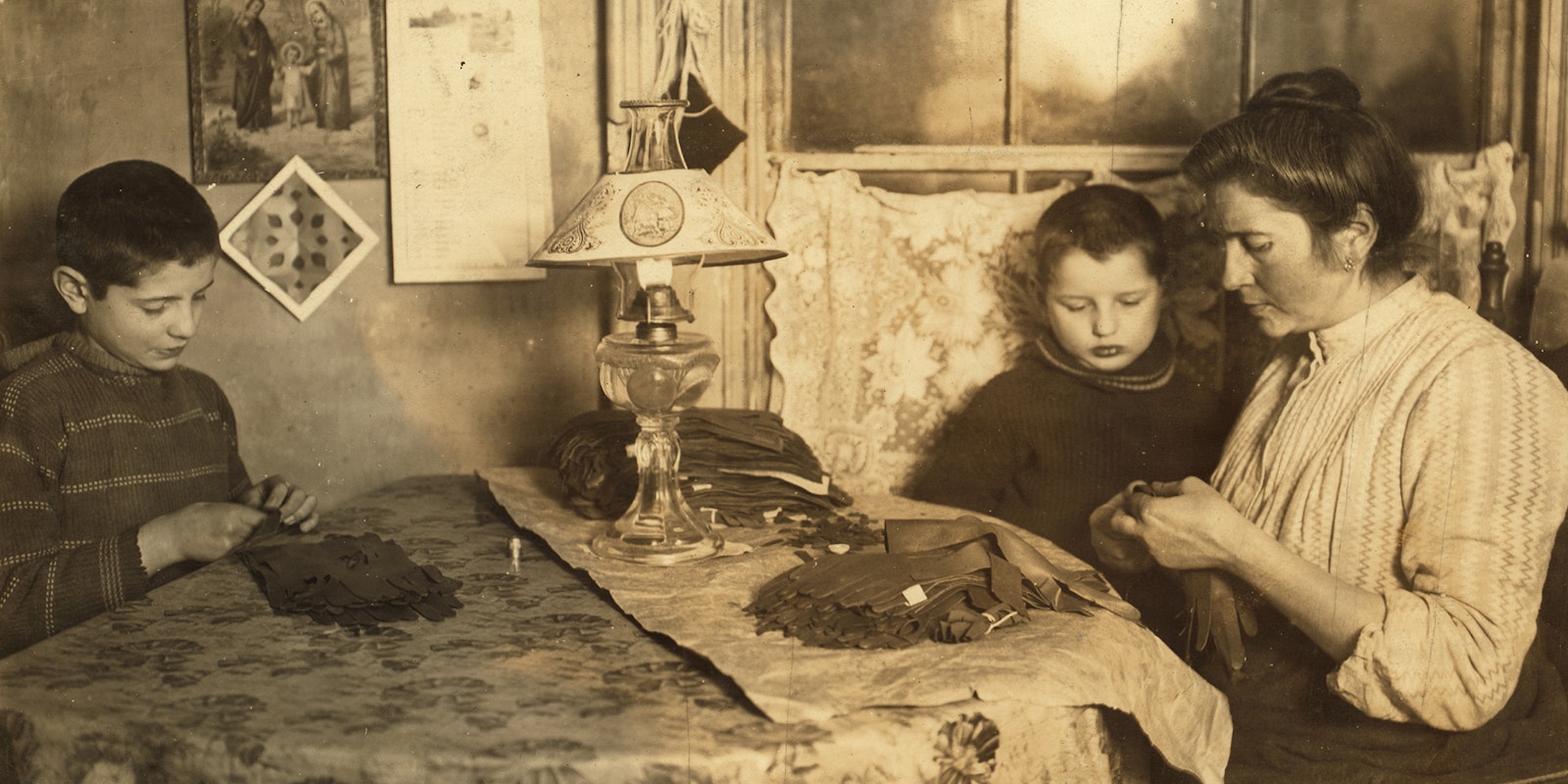In the United States in the mid to late 1800s, it was common for women to supplement the family income by sewing at home, which became more widespread with the growth of the ready-made clothing industry. In some instances, women themselves became successful needlework entrepreneurs, operating a business out of their homes.
Ready-Made Clothing and the “Putting-Out” System
Ready-to-wear is the term used for clothing made in standardized sizes to fit most people. Before the American Civil War, most clothing was made-to-measure and tailored to a particular person’s frame. The need for mass-produced military uniforms ushered in the birth of the clothing industry in the United States, which was among the country’s largest industries by 1850.
The “putting-out” system answered the need for a large, flexible workforce that could be available on a remote, as-needed basis. To meet the demand for ready-made garments, male clothiers (including clothing manufacturers and labor contractors) subcontracted the sewing work to women working out of their homes.
Needlework for Necessities
In the best circumstances, married women sold their sewing skills to supplement their husbands’ earnings. Sewing for a few hours a day could provide extra income to help pay a doctor’s bill, buy new shoes, or cover expenses when a husband was out of work. Most working-class women sewed because they needed as much money as possible. Employers paid by the piece and rates were low, so long hours were needed to earn even a subsistence wage. And since the women worked at home, the expenses of rent, fuel, candles, and, in some cases, thread, came out of their meager earnings.
Beginning with pre-cut cloth, received as bundles containing material for one garment, women handsewed the pieces together using their own modest tools, including shears, needles, bodkins, sleeve boards, and irons. Their work, considered unskilled because it involved only straight sewing, typically included basting, seaming, making buttonholes, and sewing on buttons. In most cases, sewers also washed, ironed, and folded the clothing before returning it to the shop to receive payment for their work.
 A cutout of a shirtwaist with tucks sewn by hand, 1912, New York, New York.
A cutout of a shirtwaist with tucks sewn by hand, 1912, New York, New York.
Hastings Needle Work Company
With few exceptions, poor, working-class women comprised much of the unskilled labor force that worked for the male-dominated ready-made clothing industry. One example of a woman-owned, skilled needlework business is Hastings Needle Work, owned and operated by sisters Alice LeDuc and Florence LeDuc in Hastings, Minnesota, between 1888 and 1922. The LeDuc sisters, with help from their mother and their niece, Edith LeDuc Gardner, designed, embroidered, and finished pieces that were sold across the United States. Operating out of their family home, Florence and Alice kept meticulous records of their work, including time, materials, and stitch methods associated with each piece. This information was used to calculate the customer’s final price.
Women Employing Women
As business increased, the LeDuc sisters hired local women, skilled needleworkers of the leisure class, to help with the embroidery of items including pillows, table linens, and various bags. Deemed suitable work for “respectable” women, the decorative art of embroidery provided women in and around Hastings a little extra spending money and helped fill their leisure hours.
When they closed shop in 1922, Alice and Florence LeDuc’s cottage industry produced more than 2,100 pieces in over 34 years of business. The sisters continued to earn a living with their creative skills, crafting wood-block-printed greeting cards and hand-painted lampshades and china.
 Making lace collars at home, 1911, New York, New York.
Making lace collars at home, 1911, New York, New York.
Plain and Fancy
While working-class women undertook sewing as paid labor to earn a living, women of the leisure class often acquired needlework skills as “work” but not as necessary employment. That the acquisition of handwork expertise also gave women a marketable skill highlights the importance of needlework to women of this era.
Resources
- Adams, Jim. “Descendants Return, Explore LeDuc Legacy,” May 18, 2012, startribune.com/descendants-return-explore-leduc-legacy/151784615.
- Barm, Ava and Klepp, Susan E. “If I Didn’t Have My Sewing Machine . . .: Women and Sewing Machine Technology.” In A Needle, a Bobbin, a Strike: Women Needleworkers in America, edited by Joan M. Jensen and Sue Davidson, 20–59. Philadelphia: Temple University Press, 1984.
- Braaten, A. W. “Hastings Needle Work: Women Creating, Women Providing.” Minnesota History, 60(2) (2006): 66–76.
- Edwards, Clive. “Home Is Where the Art Is: Women, Handicrafts and Home Improvements 1750-1900.” Journal of Design History, 19(1) (2006): 11–21.
- Scott, Joan Wallach. “The Mechanization of Women’s Work.” Scientific American, 247(3) (1982): 166–187.
- Zakim, Michael. “A Ready-Made Business: The Birth of the Clothing Industry in America.” The Business History Review, 73(1) (1999): 61–90.
Marsha Borden is a Connecticut-based needleworker and textile artist. Granny squares are her absolute favorite things to crochet. Find her @marshamakes on Instagram and at marshaborden.com.

